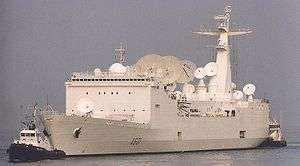Command ship

Command ships serve as the flagships of the commander of a fleet. They provide communications, office space, and accommodations for a fleet commander and his staff, and serve to coordinate fleet activities.
An auxiliary command ship features the command and control components prevalent on landing ships (command) and also feature the capability to land troops and equipment. These forces will be slightly less than those on a pure landing ship due to the nature of the ship as a command vessel and hence will also house the assault commander, the flotilla commander or someone of similar status (generally of NATO OF-7 or OF-8 rank—such as a major general or vice admiral).
Currently, the United States Navy operates two command ships, USS Blue Ridge and USS Mount Whitney, both of the purpose-built Blue Ridge class. USS La Salle was decommissioned in March 2005 and sunk as a target in support of a fleet training exercise on 11 April 2007. USS Coronado was decommissioned and sunk as part of live-fire exercise Valiant Shield 2012.[1]
The Soviet Union operated several space programme command ships, Akademik Sergey Korolev, Kosmonavt Vladimir Komarov, Kosmonavt Yuri Gagarin, and the Soviet communications ship SSV-33 Ural. These ships greatly extended the tracking range when the orbits of cosmonauts and unmanned missions were not within range of Soviet land-based tracking stations.[2] Similar U.S. vessels included USNS Observation Island.
See also
References
- ↑ "U.S. Navy conducts SINKEX as part of Valiant Shield 2012". Pearl Harbor, Hawaii: Commander, United States Pacific Fleet. 12 September 2012. Retrieved 16 September 2012.